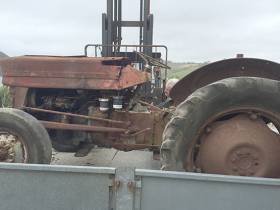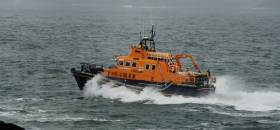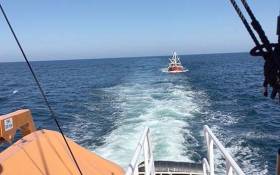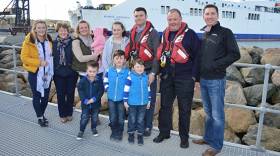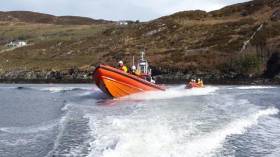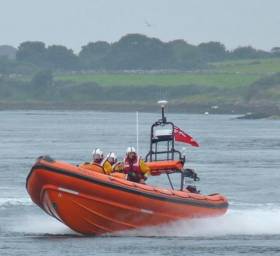Displaying items by tag: RNLI
Answer the RNLI’s Mayday Call & Help Save Lives at Sea
People across Ireland are being encouraged to help raise vital funds for the RNLI as part of the charity’s national annual fundraising event, Mayday.
The RNLI’s Mayday campaign runs through to the May Day bank holiday next Monday 2 May, with street collections and fundraising events taking place across the country.
RNLI lifeboat crew members are volunteers and remain on call 24 hours a day, and when the pager goes off they’ll drop everything to help somebody in need - often sacrificing their work and personal commitments.
David Howard, volunteer crew member at Howth lifeboat station, knows only too well the sacrifices that RNLI volunteers need to be willing to make, in order to drop everything and save lives at sea.
After months of secret preparation, David was all set to finally pop the question on Christmas Eve night. He had the specially designed ring in his hand and he was just waiting for his girlfriend to come home so he could get down on one knee and ask her to marry him – but then his pager beeped.
Abandoning his plans, David dashed to the lifeboat station. One minute he was plucking up the courage to propose, the next minute he was in the lifeboat out at sea saving a fisherman with head injuries.
On Christmas morning, David was finally able to get down on one knee and ask his girlfriend to marry him. And, of course, she said yes!
David said: ‘When the pager beeped, I didn’t think twice before dashing straight to the lifeboat station. Like all of the RNLI’s volunteer crew members, I know that when the pager beeps, every second counts, so you have to stop whatever you’re doing to go and save lives at sea.
‘The way I was going to propose was carefully planned to the finest detail, but all of those plans went out of the window when the pager went off. Luckily, I was able to pop the question the next day, and I was over the moon when she said yes.’
Every day is Mayday for the RNLI’s lifeboat crews, who are specially-trained volunteers, on-call 24/7 to save lives at sea. Whatever the weather, day or night, they are ready to drop everything and launch the lifeboats to rescue anyone in danger at sea. But, as a charity, the lifesaving service they provide is only possible thanks to the generous support of the public.
Many of the Mayday fundraising events have a yellow welly theme, in a nod to the essential kit that the RNLI’s lifeboat crew members wear on their feet when they go out to sea to save lives.
The charity is encouraging people to show their support by using the hashtag #MaydayEveryday on social media, buying and wearing a Mayday yellow welly pin badge, hosting or supporting a fundraising event or donating online.
Money raised through Mayday fundraising events will support the RNLI’s lifesaving work – it could be used to fund crew training, buy new crew kit, or contribute towards the running costs of a lifeboat station.
Visit RNLI.org/Mayday to donate, to order a pin badge or to see what other ways you can support the RNLI’s Mayday campaign.
The RNLI operates 45 lifeboat stations around Ireland. Last year, RNLI lifeboat crews in Ireland launched 1,098 times bringing 1,244 people to safety.
A UK Agricultural Engineering lecturer is to travel to Union Hall, Cork this July to undertake a challenge to rebuild a Massey Ferguson tractor in 24-hours, with a little help from colleagues and friends. The tractor will then be raffled off to raise funds for Union Hall RNLI.
Michael O’Sullivan is a lecturer in Wiltshire College, England and has a home in Union Hall, where his father was born. Michael approached Union Hall RNLI some months ago with his unique fundraising idea and asked them if they could source a dilapidated tractor for the 24-hour challenge. They could and they did and plans are now in place for the 24-hour rebuild on Wednesday 13 July 2016 on Keelbeg Pier in Union Hall.
Commenting on the novel fundraiser Pamela Deasy, Union Hall RNLI Lifeboat Press Officer said, ‘This wonderful project, to be carried out with the help of the local community, will raise much needed funds for Union Hall RNLI. We are passionate about three things in this part of the world; the sea, our sport and the land and this project encompasses two out of three of them.
‘Some years ago we saw a need for a lifeboat service here and we approached the RNLI to consider our proposal. Even before there was a lifeboat in Union Hall the community raised funds for the charity. The awful tragedy with the Tit Bonhomme in 2012 brought home to us how unpredictable the sea can be and how many families have lost loved ones to it. In 2014 the RNLI established a lifeboat station in Union Hall with an Atlantic class inshore lifeboat on a two year trial. Since that time the volunteer lifeboat crew has responded to 17 callouts and brought 21 people to safety.’
The parts for the tractor are being donated to the project by AGCO and it is hoped to be able stream the 24-hour challenge live online.
Three volunteers from Portrush RNLI came to the aid of a man in need of emergency medical assistance on Saturday afternoon (23 April).
Following a routine training exercise on the all-weather and inshore lifeboats, volunteer Karl O’Neill, who is also an RNLI lifeguard supervisor, was enjoying a cup of coffee in Portrush with Second Coxswain Mark Mitchell and trainee mechanic Chris Dobbin, when at approximately 1pm the alarm was raised that a man was thought to be having a heart attack nearby.
The crew immediately went to the man’s assistance with Karl requesting that someone get his lifeguarding first responder bag from his car.
The three crew members using their RNLI training assessed the man and found that he was oxygen dependent but not having a heart attack.
With the casualty floating in and out of consciousness, the crew quickly administered casualty care using the oxygen cylinder from the first aid bag.
The man responded immediately to the oxygen before he was transferred as a precautionary measure into the care of an ambulance crew.
Speaking following the incident, RNLI Lifeguard Supervisor Karl O’Neill said: ‘We were happy to assist the man and would like to wish him a full recovery. This was a perfect example of the benefit of having first aid training and in this instance, a good example of RNLI lifeboat crew and lifeguards working well together and putting our skills and training in place. I always carry my RNLI first responder bag with me and thankfully on Saturday it meant this gentleman got the oxygen he needed at the right time.’
Ballyglass RNLI in 10–Hour Call Out to Assist Three Fishermen
Ballyglass RNLI has rescued three fishermen off the Mayo coast this morning, following a 10 hour call out.
The volunteer lifeboat crew was requested to launch their all-weather lifeboat at 7.45pm yesterday evening (Sunday 24 April) after a member of the public who was standing on the shore saw a vessel drifting and raised the alarm.
The fishermen were on a 75ft vessel when they got into difficulty north east of Downpatrick Head.
The lifeboat under Coxswain John Walsh and with four crew members onboard launched within minutes and made its way to the scene some six miles north of Killala.
Weather conditions at the time were described as good with a north westerly Force 3 wind blowing.
Once on scene, the lifeboat crew observed that no one was in any immediate danger and began to work with the three fishermen to set up a towline.
With a tow in place, the lifeboat began the slow passage towards Killybegs in County Donegal. The weather conditions freshened as the night entered morning.
As the lifeboat approached Killybegs at 3am, it was met by a tug at Rotten Island and the tow was passed over. The tug proceeded to bring the fishing vessel the remaining distance into the harbour at Killybegs.
With all safe and well, the lifeboat crew began their return journey arriving back at Ballyglass at six o’clock this morning (Monday 25 April).
Speaking following the call out, Agatha Hurst, Ballyglass RNLI Volunteer Lifeboat Press Officer said: ‘We would like to commend the member of the public who observed from the shore that the fishing vessel was experiencing some problems. It was a long call out for our volunteers but they were more than happy to work throughout the night to ensure the crew and their vessel was safely returned to shore.’
Fethard Lifeboat Launches In Search For Missing Person
#RNLI - Fethard RNLI launched their inshore lifeboat yesterday afternoon (Wednesday 20 April) following concerns that a person may have been missing on the Hook Peninsula in Co Wexford.
The alarm was raised when a man did not return from a walk at Hook Head when expected.
The volunteer lifeboat crew responded quickly to a launch request by the Irish Coast Guard following the report at 4.30pm.
The D-class lifeboat Tradewinds, helmed by John Colfer together with three volunteer lifeboat crew, launched at Slade Harbour within minutes following the pager alert, assisted by five shore crew who began a shoreline search.
At 5.15pm the search was stood down with the notification that the man was found safe and well.
Speaking following the callout, Fethard RNLI deputy launching authority Hugh Burke said: "We would like to commend the member of the public who raised the alarm today when they were concerned. We would always rather launch to a false alarm with good intent than not launch at all.
"Our volunteers responded quickly this afternoon to aid in the search at sea and on the shore but we were stood down quickly on hearing the good news that the man was not missing but overdue and had been located safe and well."
Fethard RNLI is always looking for new volunteers from all walks of life to join their lifesaving team.
If you are aged 17 or over and would like to find out more please contact the lifeboat station or make a visit during its May Bank holiday open weekend.
Wexford RNLI Rescues Lone Sailor After Yacht Hits Sandbank
Wexford RNLI rescued a lone sailor yesterday evening after his yacht hit a sandbank in heavy seas off Rosslare Point.
Volunteer lifeboat crews from Wexford and Rosslare Harbour RNLI were launched at 6.35pm following reports that a 26ft yacht had hit a sandbank somewhere off Wexford.
As little information was given on the location, both the inshore lifeboat from Wexford and the all-weather lifeboat from Rosslare Harbour proceeded to the Wexford Bar area which is known for its treacherous seas over a myriad of sandbanks.
Once on scene, Wexford RNLI spotted the vessel 100m north of Rosslare Point on Wexford Bar. Two crew members Damien Foley and David Maguire climbed onto the yacht to find a lone sailor tired from his 14 hour voyage from Fishguard.
With the yacht at anchor, the crew battled to release the anchor with waves crashing over them. The anchor broke and the yacht escaped been broken up.
The lifeboat helmed by Sinead Casey and with crew member Simon Casey also onboard, took the casualty vessel under tow and navigated its way through difficult lumpy seas out to deep water where the tow was dropped.
The crew members onboard the yacht then steamed the vessel over a dirty Wexford bar under the watchful eye off Rosslare Harbour RNLI.
The sailor and his yacht were safely brought alongside at Wexford Quay.
Speaking following the call out, Sinead Casey, Wexford RNLI helm said: ‘This was a challenging rescue but our crew who are highly skilled and trained managed to take the vessel under their control much to the relief of the tired sailor who was on a voyage from Wales to Scotland. Thanks to the great team effort by the volunteers from both Wexford and Rosslare Harbour, the sailor and his yacht were rescued from very difficult seas.’
Ballyglass RNLI Assist Fishermen on Broken Down Trawler
Ballyglass RNLI is assisting three fishermen this afternoon after their 40ft trawler got into difficulty off the Mayo coast.
The volunteer crew was requested to launch their all-weather lifeboat shortly after 10 o’clock this morning following a report that a fishing vessel with three onboard was experiencing problems some 28 nautical miles north of Benwee Head.
Weather conditions at the time were described as favourable with a calm sea and good visibility.
The lifeboat under Coxswain John Walsh and with six crew members onboard launched at 10.25am.
Once on scene approximately an hour and a half later, the lifeboat crew observed that no one was in any immediate danger and began to work with the fishing crew to set up a tow.
With a rope in place, the lifeboat began the slow tow back to Ballyglass, an ongoing passage which is expected to take five hours.
Agatha Hurst, Ballyglass RNLI Volunteer Lifeboat Press Officer said: ‘The fishermen did the right thing this morning and requested assistance when their vessel got into difficulty. The lifeboat crew successfully set up a tow and we hope to have everyone returned safe and well to Ballyglass later this afternoon.’
A Fascinating Lifeboat Man
I said words in tribute to a Lifeboatman on radio this week that I have never said before as I introduced my programme (scroll down the page for the podcast). I meant them and I was honoured to be able to speak them about a man who has spent 42 years with the RNLI at what I regard as a famous lifeboat station. This is what I said on the programme:
“Thank you for joining me on this marine voyage in which we will hear a particularly interesting interview with a lifeboatman and the changes he has experienced in a 42-year career with the RNLI, Tony Kehoe of the famous Rosslare Lifeboat Station talks frankly about a life rescuing people in trouble at sea in a way in which I’ve never before heard a lifeboatman being so direct and clear about the good, the bad and the tough aspects of a career aboard lifeboats.”
Tony spoke of rescue work in older lifeboats and how they could be hard to handle! And about a time when “someone knocked on your door in the middle of the night and said you were needed at the lifeboat…” He talked of the changes, particularly in the speed of lifeboats getting to the scene of a rescue or tragedy faster and requiring quicker responses by the crew to a variety of issues arising from that speed over the water and also, what it does to the body physically, when hitting waves at speeds of 16 knots and more, rather than 8 knots in older boats.
He comes of a family with huge commitment to the lifeboat service and two of his sons also joined Rosslare Station. I was very impressed by his interview and particularly what he told Niamh Stephenson, also of the RNLI who did the interview for the programme, about the most important requirements for a good lifeboat crew ---- “being part of a team, trusting each other..” and his final wish for those who carry on the service: “Mind yourselves….”
I am confident that you will enjoy listening to his interview and will appreciate even more, the value of the lifeboat service when you have heard it.
In that regard I commend to you May Day, Sunday May 1, at the National Concert Hall in Dublin, where I intend to be, to hear the Wexford Sinfonia Orchestra play their five-part suite, ‘HEROES OF THE HELEN BLAKE,’ a tribute to the men of the Fethard-on-Sea Lifeboat who died in the rescue service to the sailing cargo ship, Mexico. The members of the orchestra range in age from 14 to 80. The performance will begin at 3 p.m. MAY DAY is the annual Fundraising Day for the lifeboats. Tickets are €20, students €15 and can be bought at the Box Office at the Concert Hall or online at www.nch.ie Do support the lifeboats on this day….
THIS ISLAND NATION reports on the maritime traditions, culture, history and modern marine developments in our island nation. Your comments are always welcome. Email: [email protected]
East Meets West As Skerries Lifeboat Crew Visits Clifden
#RNLI - Skerries RNLI's volunteer crew headed to the West of Ireland this month as they paid a visit to their colleagues in Clifden RNLI.
Once a year the volunteers in Skerries undertake a team-building and fact-finding trip to other rescue services and lifeboat stations.
Despite being located on opposite sides of the country, Skerries RNLI and Clifden RNLI had previously exercised together, along with Clogherhead RNLI, off the East Coast back in 2014.
On that occasion the Clifden crew were being trained on the Mersey-class all-weather lifeboat that the station took on for a 12-month trial.
Last Saturday (16 April), Clifden RNLI launched all three of their lifeboats – a Mersey-class, an Atlantic 85 inshore lifeboat and a D-class inshore lifeboat – to take the volunteers from Skerries afloat and give them a taste of the challenges they faced on the West Coast and at their own station in particular.
Skerries RNLI would like to thank volunteers Philip Ferguson and Laura Boylan for organising the trip; Irish Rail, who very generously subsidised the travel costs; and most importantly all, the volunteers at Clifden RNLI for giving up their time and extending a warm welcome.
Speaking about the exercise, Skerries RNLI volunteer lifeboat press officer Gerry Canning said: "It’s always a great learning experience for our volunteers to see the challenges that face other crews around the coast, and how they deal with them.
"The guys from Clifden RNLI were fantastic and really pulled out all the stops to make sure we went afloat and got a good insight into why they require each of their boats."
#RNLI - Portaferry RNLI's volunteer lifeboat crew were called out yesterday afternoon (Sunday 17 April) to assist a 36ft angling vessel which had run into difficulty north of the South Rock Light Buoy near Portaferry, Co Down.
The alarm was raised just before 12.25pm and the lifeboat was dispatched to the scene, some 10 miles east of the lifeboat station.
The angling boat, with three people on board, had developed engine problems in what were described as calm conditions with a Force 3 wind and a slight sea swell.
When on scene, the lifeboat crew checked everyone was okay before taking the vessel under tow to Portavogie, arriving there at 2pm. The lifeboat was back on station at 2.30pm.
Commenting on the callout, Portaferry RNLI lifeboat operations manager Brian Bailie said: "This was a fairly routine callout for the lifeboat crew and we were glad to be able to offer assistance.
"However as we approach the busy season and more people are taking to the water for leisure we would advise the public to make sure they check all their equipment is in proper working order."
The RNLI offers sea safety advice online at RNLI.org/RespectTheWater



























